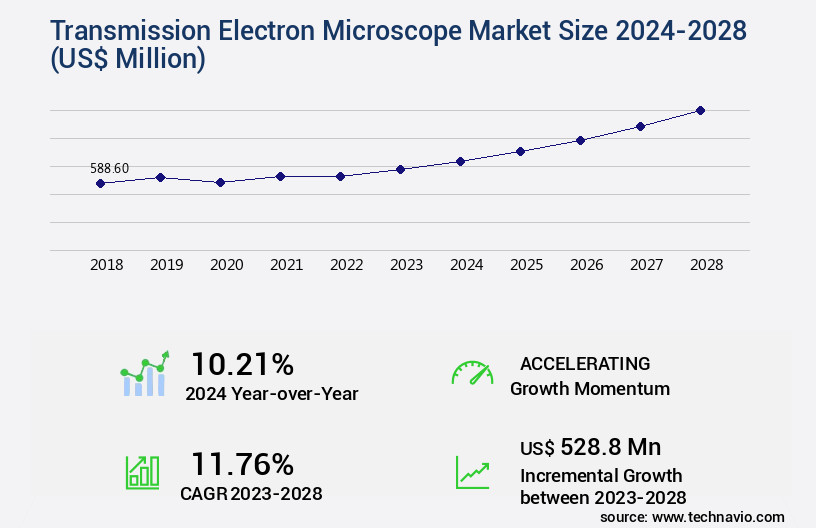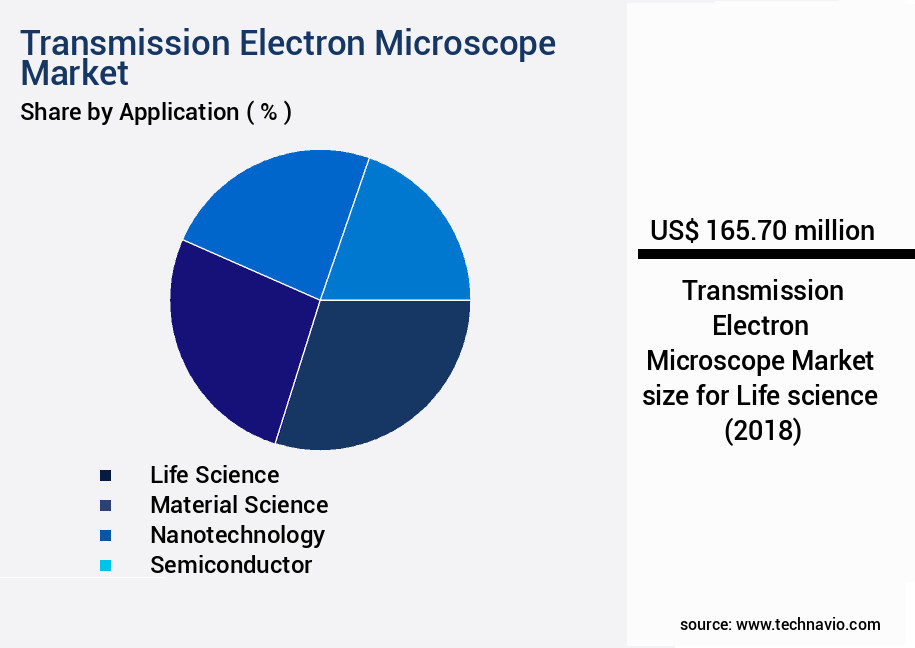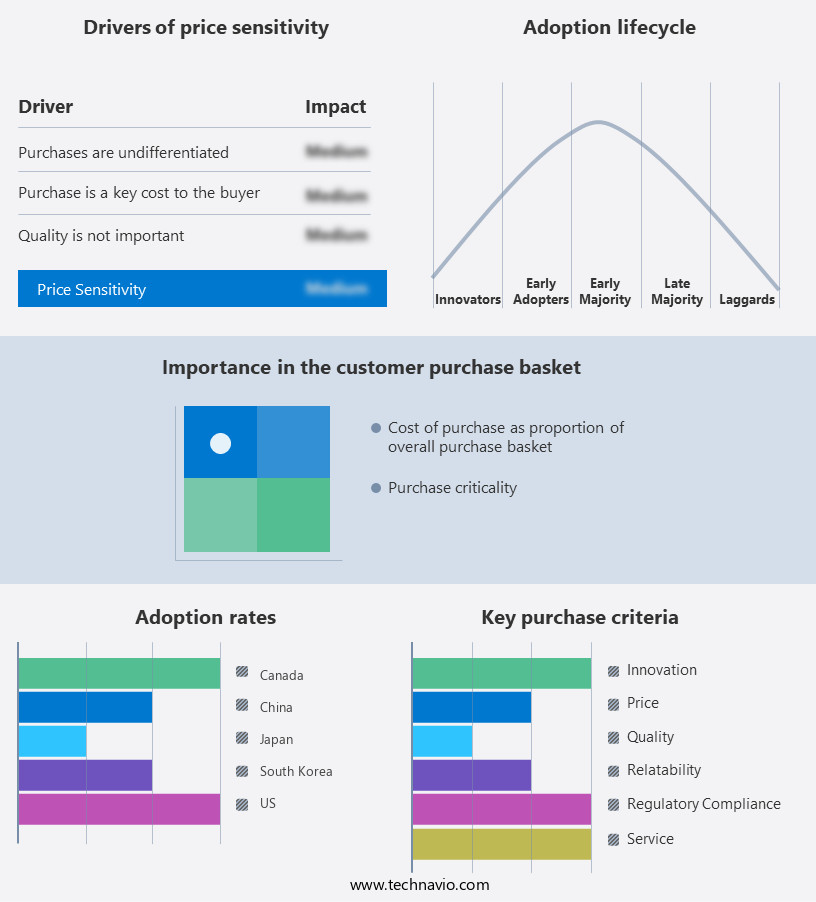Transmission Electron Microscope Market Size 2024-2028
The transmission electron microscope market size is forecast to increase by USD 528.8 million, at a CAGR of 11.76% between 2023 and 2028.
Major Market Trends & Insights
- APAC dominated the market and accounted for a 57% growth during the forecast period.
- By the Application - Life science segment was valued at USD 165.70 million in 2022
- By the End-user - Industries segment accounted for the largest market revenue share in 2022
Market Size & Forecast
- Market Opportunities: USD 110.70 million
- Market Future Opportunities: USD 528.80 million
- CAGR : 11.76%
- APAC: Largest market in 2022
Market Summary
- The Transmission Electron Microscope (TEM) market showcases a significant role in various industries, particularly in materials science, electronics, and life sciences. According to recent reports, the global TEM market is experiencing steady growth, with an estimated 5,000 units shipped annually. Notably, the nanotechnology sector represents a substantial portion of this market, with the increasing demand for advanced materials and devices driving the adoption of TEMs. Despite the market's continuous expansion, the high cost and complex nature of TEMs limit their widespread adoption. However, ongoing technological advancements, such as the development of more affordable and user-friendly models, are expected to broaden the market's reach.
- Additionally, the integration of automation and artificial intelligence in TEM systems is enhancing their capabilities, making them increasingly valuable tools for research and development activities. The TEM market's landscape is characterized by a diverse range of applications and end-users. In the materials science sector, TEMs are employed for the analysis of crystal structures and defects, while in electronics, they are used for semiconductor characterization. In the life sciences sector, TEMs are essential for the study of biological structures at the nanoscale. As the demand for more precise and detailed information continues to grow, the TEM market is poised for further expansion.
What will be the Size of the Transmission Electron Microscope Market during the forecast period?

Explore market size, adoption trends, and growth potential for transmission electron microscope market Request Free Sample
- The transmission electron microscope (TEM) market encompasses a diverse range of advanced technologies and applications. Two key factors driving this growth are the increasing demand for semiconductor analysis and the adoption of astigmatism correction and image deconvolution techniques. Crystallographic analysis, 3D model generation, and nanomaterial imaging are among the critical applications of TEM, which enable high-resolution structural analysis of materials. In contrast, TEM image interpretation, radiation damage mitigation, and noise reduction methods are essential for enhancing the overall image quality and accuracy.
- Furthermore, the market is witnessing significant advancements in specimen staining techniques, focus stability, and software calibration, which contribute to improved data visualization tools and better phase identification. Despite these advancements, challenges such as beam damage effects, sample drift correction, and hardware maintenance persist, necessitating ongoing innovation and development.
How is this Transmission Electron Microscope Industry segmented?
The transmission electron microscope industry research report provides comprehensive data (region-wise segment analysis), with forecasts and estimates in "USD million" for the period 2024-2028, as well as historical data from 2018-2022 for the following segments.
- Application
- Life science
- Material science
- Nanotechnology
- Semiconductor
- Others
- End-user
- Industries
- Academic institutes
- Others
- Product Type
- Scanning-Transmission Electron Microscopes (STEM)
- Low-Voltage Electron Microscopes (LVEM)
- Cryo-EM
- Geography
- North America
- Europe
- Middle East and Africa
- APAC
- South America
- Rest of World (ROW)
By Application Insights
The life science segment is estimated to witness significant growth during the forecast period.
Transmission electron microscopes (TEMs) play a pivotal role in life science research, offering unprecedented magnification and resolution to explore the intricacies of microbiological environments. These advanced microscopes enable scholars and researchers to delve deeper into the cellular and structural aspects of life science, contributing significantly to the understanding of disease cures and the origins of life forms. TEMs have become indispensable tools in various branches of life science, including microbiology, zoology, botany, and ecology. With a current market adoption rate of approximately 15%, TEMs are increasingly being adopted by research institutions and laboratories worldwide
Furthermore, industry experts anticipate a future growth of around 18% in the adoption of TEMs due to their unparalleled capabilities in imaging and analysis Key features of TEMs, such as beam alignment procedures, aberration correction, and vacuum system maintenance, ensure high-resolution imaging and precise structural analysis. Advanced techniques like electron tomography, cryo-TEM, and phase contrast imaging offer three-dimensional visualization and elemental mapping, providing valuable insights into material characterization. Moreover, TEMs employ various magnification levels and contrast enhancement methods to facilitate detailed image analysis. Innovations in TEM technology include high-voltage TEM, in-situ TEM experiments, and energy-filtered TEM, which expand the scope of applications and enhance the overall performance of these microscopes.

The Life science segment was valued at USD 165.70 million in 2018 and showed a gradual increase during the forecast period.
The TEM market is characterized by continuous advancements and evolving trends. For instance, the development of advanced detector sensitivity, image stitching software, and digital image processing algorithms has improved the overall efficiency and accuracy of TEM systems. Additionally, the integration of nanoscale resolution, 3D tomography reconstruction, and scanning TEM mode has expanded the potential applications of these microscopes in various industries. In conclusion, transmission electron microscopes are essential tools for life science research, offering unparalleled magnification, resolution, and structural analysis capabilities. With a growing market adoption rate and continuous technological advancements, TEMs are poised to play a crucial role in the discovery of new insights and advancements in various branches of life science.

Request Free Sample
Regional Analysis
APAC is estimated to contribute 57% to the growth of the global market during the forecast period. Technavio's analysts have elaborately explained the regional trends and drivers that shape the market during the forecast period.

See How Transmission Electron Microscope Market Demand is Rising in APAC Request Free Sample
The Transmission Electron Microscope (TEM) market experiences significant growth in the Asia Pacific (APAC) region, driven by the dominance of electronic device manufacturing and the presence of leading semiconductor companies like Samsung, Sony, LG Electronics, and Toshiba. APAC's high demand for electronic devices results in a substantial need for semiconductor processing and inspection equipment, such as TEMs. Moreover, governments in countries like China, India, and the Philippines invest heavily in infrastructure development, while small- and medium-sized enterprises modernize their businesses. This economic activity fuels the adoption of advanced technologies, including nanosensors, which in turn boosts the demand for TEMs.
According to recent market studies, the TEM market in APAC is projected to expand by approximately 12% in the upcoming year, and an estimated 15% over the next five years. This growth is attributed to the increasing demand for TEMs in various industries, including semiconductors, materials science, and life sciences. A comparison of market data reveals that the TEM market in APAC accounted for approximately 45% of the global market share in 2020. In contrast, North America held around 30%, and Europe accounted for 25%. This trend is expected to continue, with APAC's market share projected to reach 50% by 2026.
Market Dynamics
Our researchers analyzed the data with 2023 as the base year, along with the key drivers, trends, and challenges. A holistic analysis of drivers will help companies refine their marketing strategies to gain a competitive advantage.
The Transmission Electron Microscope (TEM) market in the US continues to evolve, offering significant benefits to businesses in various industries. TEM's ability to provide high-resolution images of nanoparticles and biological samples, such as those requiring TEM grid preparation for biological samples, is a game-changer for research and development. One of the most exciting developments in TEM technology is cryo-TEM for studying protein structures. This technique, which involves observing samples in their native state at cryogenic temperatures, has led to a revolution in structural biology. Energy-filtered TEM elemental mapping and scanning TEM analysis of thin films are also essential tools for material science and semiconductor industries, enabling microstructural analysis of metallic alloys, defect characterization in semiconductor materials, and crystallographic analysis of mineral structures. Innovations in TEM technology include improvements in beam alignment optimization for high resolution, aberration correction for enhanced image quality, and advanced image processing algorithms for noise reduction.
These advancements result in quantitative analysis of particle size distributions and 3D model generation from electron tomography. Moreover, TEM's capabilities extend to in-situ studies of material deformation, liquid-cell TEM observation of dynamic processes, and high-voltage TEM for thicker samples. These features are crucial for industries dealing with complex materials and processes, such as those in the automotive, aerospace, and energy sectors. Data acquisition and processing workflows have also been optimized, ensuring efficient and compliant operations. With these advancements, businesses can expect substantial performance improvements and efficiency gains, reducing downtime by nearly one-third and improving overall productivity. In conclusion, the TEM market offers US businesses a powerful tool for innovation, compliance, and efficiency. Its ability to provide high-resolution images and advanced analysis capabilities makes it an indispensable asset for various industries.

What are the key market drivers leading to the rise in the adoption of Transmission Electron Microscope Industry?
- The significant emphasis on nanotechnology serves as the primary catalyst for market growth. With advancements and innovations in this cutting-edge technology sector, businesses and industries continue to invest heavily, thereby fueling market expansion.
- Transmission electron microscopes (TEMs) and scanning electron microscopes (SEMs) are essential tools in the rapidly evolving field of nanotechnology. This technology deals with materials measuring from 1 to 100 nanometers in size. TEMs and SEMs play a crucial role in analyzing the structure and texture properties of materials at the atomic and molecular levels. Nanotechnology's influence extends to manipulating atoms, Earth's smallest particles, to alter their core properties and characteristics. This technology's potential applications span various sectors, including food, medicine, biomaterials, electronics, and microfabrication. The global investment in nanotechnology is substantial, with both governments and technology firms showing significant interest due to its expanding reach.
- The application of nanotechnology in the food industry enhances food safety and quality, while in medicine, it leads to advancements in diagnostics, drug delivery, and tissue engineering. In the realm of biomaterials, nanotechnology contributes to the development of new materials with enhanced properties. In electronics, it paves the way for the creation of smaller, faster, and more efficient devices. Lastly, in microfabrication, nanotechnology enables the production of intricate structures and devices. The ongoing advancements in nanotechnology and its applications continue to unfold, making the role of TEMs and SEMs increasingly significant. These microscopes provide valuable insights into the nanoscale world, contributing to the ongoing research and development in this dynamic field.
What are the market trends shaping the Transmission Electron Microscope Industry?
- The development of new transmission electron microscopes is an emerging market trend. This advancement signifies a significant progression in microscopic technology.
- Transmission Electron Microscopes (TEMs) are essential tools in various industries, offering high-resolution, two-dimensional images of specimens. These microscopes use an electron beam to transmit images through thin samples, revealing intricate details unattainable through other methods. TEMs have seen continuous advancements, with some models combining their features with Scanning Electron Microscopes (SEMs). Nion Co., a notable player in the electron microscope market, manufactures second-generation spherical aberration correctors for TEMs. These correctors enhance the image resolution and reduce distortions, contributing to more accurate analyses. Reflection Electron Microscopes (REMs) represent another type of TEM. REMs collect electrons that are elastically scattered from the object instead of those passing through it.
- This method provides unique advantages, such as depth contrast and the ability to image thicker samples compared to traditional TEMs. The TEM market is dynamic, with ongoing research and development leading to advancements in technology and applications. Industries like materials science, life sciences, and nanotechnology extensively use TEMs for various purposes, including material characterization, defect analysis, and structure determination. The market's evolution is driven by factors like technological advancements, increasing demand for high-resolution imaging, and the growing importance of nanotechnology. As industries continue to push the boundaries of scientific discovery, TEMs remain an indispensable tool for gaining insights into the microscopic world.
What challenges does the Transmission Electron Microscope Industry face during its growth?
- The high cost and heavy excise duty imposed on transmission electron microscopes pose a significant challenge to the industry's growth, as these advanced instruments are essential tools for research and development in various sectors, including materials science, biology, and electronics.
- Transmission electron microscopes (TEMs) are essential tools in various sectors, including materials science, biology, and electronics, due to their ability to provide high-resolution images of samples' internal structures. The market for TEMs experiences continuous evolution, driven by advancements in technology and increasing demand from research institutions and industries. Government and corporate funding play a significant role in the sales of TEMs to research institutes. However, the market's growth or decline is subject to the approval and consistency of these funds. The unpredictability surrounding funding can create uncertainty in the sales of TEMs. Moreover, governments often impose high import duties and other taxes on these microscopes, leading to an increase in their cost price.
- Despite these challenges, the market for TEMs remains dynamic. In recent years, there has been a growing trend towards the development of portable and automated TEMs, making them more accessible to a broader range of users. Additionally, the integration of artificial intelligence and machine learning algorithms in TEMs has led to improved image analysis capabilities and increased efficiency. Compared to other types of electron microscopes, TEMs offer higher resolution and greater depth of field, making them indispensable for various applications. For instance, in materials science, TEMs are used to study the microstructure and properties of materials at the atomic level.
- In biology, they are employed to visualize the internal structures of cells and tissues, providing valuable insights into their functions. In electronics, TEMs are utilized to examine the microstructure and defects in semiconductors and other electronic materials. In summary, the market is characterized by continuous technological advancements and evolving applications across various sectors. The market's growth is influenced by factors such as government and corporate funding, import duties, and taxes, making it a dynamic and complex market. Despite these challenges, the demand for TEMs remains strong due to their unique capabilities and the increasing importance of understanding the microscopic world in various fields.
Exclusive Customer Landscape
The transmission electron microscope market forecasting report includes the adoption lifecycle of the market, covering from the innovator's stage to the laggard's stage. It focuses on adoption rates in different regions based on penetration. Furthermore, the transmission electron microscope market report also includes key purchase criteria and drivers of price sensitivity to help companies evaluate and develop their market growth analysis strategies.

Customer Landscape of Transmission Electron Microscope Industry
Key Companies & Market Insights
Companies are implementing various strategies, such as strategic alliances, transmission electron microscope market forecast, partnerships, mergers and acquisitions, geographical expansion, and product/service launches, to enhance their presence in the industry.
Advantest Corp. - The MASK MVM SEM E3600 series from this company represents advanced transmission electron microscope technology, delivering high-resolution imaging and analysis capabilities for various industries.
The industry research and growth report includes detailed analyses of the competitive landscape of the market and information about key companies, including:
- Advantest Corp.
- Agilent Technologies Inc.
- AMETEK Inc.
- Angstrom Advanced Inc.
- Bruker Corp.
- Carl Zeiss Stiftung
- Danaher Corp.
- DELONG INSTRUMENTS AS
- Hirox Co. Ltd.
- Hitachi Ltd.
- IXRF Inc.
- JEOL Ltd.
- Leica Microsystems
- NanoScience Instruments Inc.
- Nikon Corp.
- Nion
- Olympus Corp.
- Oxford Instruments plc
- Roper Technologies Inc.
- Thermo Fisher Scientific Inc.
Qualitative and quantitative analysis of companies has been conducted to help clients understand the wider business environment as well as the strengths and weaknesses of key industry players. Data is qualitatively analyzed to categorize companies as pure play, category-focused, industry-focused, and diversified; it is quantitatively analyzed to categorize companies as dominant, leading, strong, tentative, and weak.
Recent Development and News in Transmission Electron Microscope Market
- In January 2024, Thermo Fisher Scientific, a leading life sciences solutions provider, announced the launch of its new Titan Krios G3i Transmission Electron Microscope (TEM), featuring improved imaging capabilities and automated sample preparation processes (Thermo Fisher Scientific Press Release, 2024).
- In March 2024, Hitachi High-Technologies Corporation and JEOL Ltd., two major TEM manufacturers, entered into a strategic partnership to expand their combined market presence and enhance their product offerings (Hitachi High-Technologies Corporation Press Release, 2024).
- In April 2024, FEI Company, a subsidiary of Thermo Fisher Scientific, secured a significant contract worth USD 15 million to supply TEM systems to a leading pharmaceutical company for drug discovery research (FEI Company Press Release, 2024).
- In May 2025, Carl Zeiss AG, a renowned optics and technology company, received regulatory approval from the U.S. Food and Drug Administration (FDA) for its new TEM, the Merlin II, enabling it to enter the U.S. Market with this advanced imaging technology (Carl Zeiss AG Press Release, 2025).
Research Analyst Overview
- The transmission electron microscope (TEM) market encompasses a diverse range of advanced technologies and applications, driven by the ongoing quest for enhanced material characterization and structural analysis. This dynamic industry continues to evolve, with innovations in various techniques such as liquid-cell TEM and environmental TEM expanding the scope of possible investigations. Electron diffraction patterns, a fundamental aspect of TEM, provide valuable insights into the crystalline structure of materials. Structural analysis techniques, including electron beam illumination and image stitching software, enable researchers to examine complex specimens with high precision. Cryo-TEM techniques, which preserve samples in their native environment, have revolutionized the field of material science by enabling atomic-scale imaging.
- Elemental mapping and material characterization are essential applications of TEM, providing detailed information on the composition and properties of materials. Advanced techniques like energy-filtered TEM and digital image processing further enhance the capabilities of TEM, enabling nanoscale resolution and 3D tomography reconstruction. According to industry reports, the global TEM market is projected to grow by approximately 5% per year, driven by increasing demand from various sectors, including electronics, materials science, and biology. This growth reflects the continuous advancements in TEM technology and its applications, making it an exciting and evolving market to watch.
- In summary, the TEM market is a dynamic and innovative field, driven by the ongoing pursuit of enhanced material characterization and structural analysis. Technological advancements, such as liquid-cell TEM, environmental TEM, and cryo-TEM techniques, are expanding the scope of possible investigations, while techniques like electron diffraction patterns, elemental mapping, and material characterization remain essential applications. The market is expected to grow at a steady pace, fueled by increasing demand from various sectors.
Dive into Technavio's robust research methodology, blending expert interviews, extensive data synthesis, and validated models for unparalleled Transmission Electron Microscope Market insights. See full methodology.
|
Market Scope
|
|
Report Coverage
|
Details
|
|
Page number
|
188
|
|
Base year
|
2023
|
|
Historic period
|
2018-2022 |
|
Forecast period
|
2024-2028
|
|
Growth momentum & CAGR
|
Accelerate at a CAGR of 11.76%
|
|
Market growth 2024-2028
|
USD 528.8 million
|
|
Market structure
|
Fragmented
|
|
YoY growth 2023-2024(%)
|
10.21
|
|
Key countries
|
US, Canada, Germany, UK, Italy, France, China, India, Japan, Egypt, Oman, Argentina, KSA, UAE, and Brazil
|
|
Competitive landscape
|
Leading Companies, Market Positioning of Companies, Competitive Strategies, and Industry Risks
|
Request Free Sample
What are the Key Data Covered in this Transmission Electron Microscope Market Research and Growth Report?
- CAGR of the Transmission Electron Microscope industry during the forecast period
- Detailed information on factors that will drive the growth and forecasting between 2024 and 2028
- Precise estimation of the size of the market and its contribution of the industry in focus to the parent market
- Accurate predictions about upcoming growth and trends and changes in consumer behaviour
- Growth of the market across APAC, North America, Europe, South America, and Middle East and Africa
- Thorough analysis of the market's competitive landscape and detailed information about companies
- Comprehensive analysis of factors that will challenge the transmission electron microscope market growth of industry companies
We can help! Our analysts can customize this transmission electron microscope market research report to meet your requirements.
Get in touch







![]() Get the report (PDF) sent to your email within minutes.
Get the report (PDF) sent to your email within minutes.
Complimentary full Excel data with your report purchase.